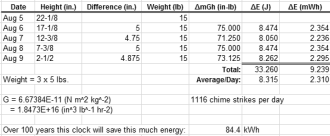|
 How much energy does it take to power a
pendulum-regulated, gravity-driven mechanical clock for a full day? I decided to
use my hand-crafted
grandmother clock as a test bed. Three 5-pound lead weights provide motivation
for countering the friction of all the gears and chime hammers. Calculation of the
energy consumption is a Physics 101 problem since the familiar governing equation
is that of potential energy in the Earth's gravitational field: How much energy does it take to power a
pendulum-regulated, gravity-driven mechanical clock for a full day? I decided to
use my hand-crafted
grandmother clock as a test bed. Three 5-pound lead weights provide motivation
for countering the friction of all the gears and chime hammers. Calculation of the
energy consumption is a Physics 101 problem since the familiar governing equation
is that of potential energy in the Earth's gravitational field:

All three weights were reset to the top of the travel and a reference measurement
was made (see photo). All three weights drive the mechanism in unison, so they fall
the same amount over time. Since I was only interested in the change in potential
energy, the change of height, not the absolute height from the Earth's center, was
needed. A convenient form of energy units is inch*pounds (in-lb), which is easily
converted to Joules (J) and milliwatt*hours (mWh). Five consecutive days of measurements
at approximately the same time (7:30 pm) resulted in the spreadsheet below.

Weight drop should be the same each day, and really probably was; the reported
differences are due to rounding to the nearest 1/8th inch each time. An average
is given to smooth out the variation. 2.31 mWh per day is not a lot of energy considering
that the weights are driving not just the clock hands, but also the hammers that
strike the chimes. In fact, striking the chimes takes much more energy than driving
the clock hands. It would be interesting - and I will likely do it at some point
- to disable the chimes and make the same set of measurements.
 At the top of each hour, this clock movement
plays the familiar Westminster melody, which is a total of 16 notes. Each quarter
hour it plays a cumulative 1/4 of the melody, that is at quarter past the hour it
plays the first four notes, at half past the hour it plays the first eight notes,
at quarter till the hour it plays the first 12 notes. So, every hour it plays 4
+ 8 + 12 + 16 = 40 notes (24 x 40 = 960 per day).
Then, it strikes once for each hour for 2 x (1+2+...+11+12) = 156 per day, for a
grand total of 1,116 chime strikes per day - that's a lot of strikes. At the top of each hour, this clock movement
plays the familiar Westminster melody, which is a total of 16 notes. Each quarter
hour it plays a cumulative 1/4 of the melody, that is at quarter past the hour it
plays the first four notes, at half past the hour it plays the first eight notes,
at quarter till the hour it plays the first 12 notes. So, every hour it plays 4
+ 8 + 12 + 16 = 40 notes (24 x 40 = 960 per day).
Then, it strikes once for each hour for 2 x (1+2+...+11+12) = 156 per day, for a
grand total of 1,116 chime strikes per day - that's a lot of strikes.
Why even bother making the energy calculation? I wanted to estimate what my carbon
credit should be for not drawing that energy from the electric grid. After all,
most crimes short of premeditated murder can be forgiven if you can demonstrate
that, especially over the last decade or two, you have made an attempt to be more
green. Green holiness points are earned by driving hybrid vehicles, installing solar
panels, using less toilet paper, showering less frequently, etc. Since electric
power in my area of Kernersville, North Carolina, is primarily coal generated
(although there is a nuclear plant over in Raleigh),
it is especially important to exhibit a greener hue.
Let us assume that my clock runs for 100 years before succumbing to wear. At
2.31 mWh of energy each day and an average of 365.24 days per year, my efforts
will have saved a whopping 844 kWh in a century†. That should
gain me absolution for at least an unarmed robbery. For comparison, a 23 W
CFL bulb would consume 0.0231 kW * 24.0 hrs/day * (365.24 days/yr
*100 yr) = 20.2E3 kWh (20.2 GWh) in the same
100 years.
† As is the custom, I will conveniently ignore the energy consumed by
all the electric power tools used while building the clock and all
the fuel used in gathering the components (wood, finishing materials, hardware).
Posted August 11, 2014
|











